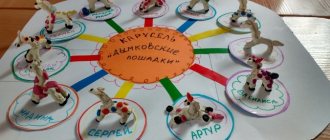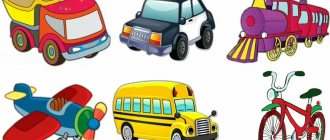Summary of GCD for drawing “Bear” in the middle group
Advanced training course for 340 rubles!
Emotional burnout of teachers. Prevention and ways to overcome
Municipal state preschool educational institution "Kindergarten No. 25"
educational activities in the middle group.
Theme of the week
: “Who is preparing for winter?”
Developed and conducted by teacher Mezentseva O.I.
Goals:
Continue to learn to master drawing examples (round and oval shapes), paint over them in a circular motion, carefully, without going beyond the contour.
Be able to convey the characteristic features of an animal (bear), observing proportions.
Fix the shape, color, size.
Foster independence and accuracy in work.
Blue cardboard (according to the number of children), paints, brushes, cups of water; templates; example of a teacher; video letter from a bear.
Preliminary work: a surprise moment at the beginning of the week a toy / gnome
/. The gnome is rearranged throughout the group during the week, unnoticed by the children, and the teacher draws the attention of the children to this.
Preliminary work:
viewing the album “Winter in the Forest”, conversation “How animals prepare for winter”, reading the poem “Why does a bear sleep in winter?” V. Orlova.
Unconventional technique of drawing animals
NON-TRADITIONAL TECHNIQUES FOR DRAWING ANIMALS
PREPARED BY:
TEACHER OF SUROOK KINDERGARTEN “SOLNYSHKO”
GRIGORYEVA T. A.
2019
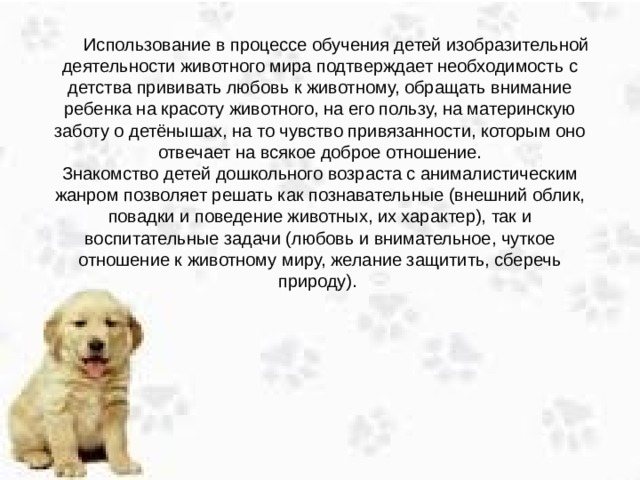
The use of visual activities of the animal world in the process of teaching children confirms the need to instill a love for animals from childhood, to draw the child’s attention to the beauty of the animal, to its benefits, to maternal care for the cubs, to the feeling of affection with which it responds to any kind attitude. Introducing preschool children to the animal genre allows them to solve both cognitive (the appearance, habits and behavior of animals, their character) and educational tasks (love and an attentive, sensitive attitude to the animal world, the desire to protect and preserve nature).
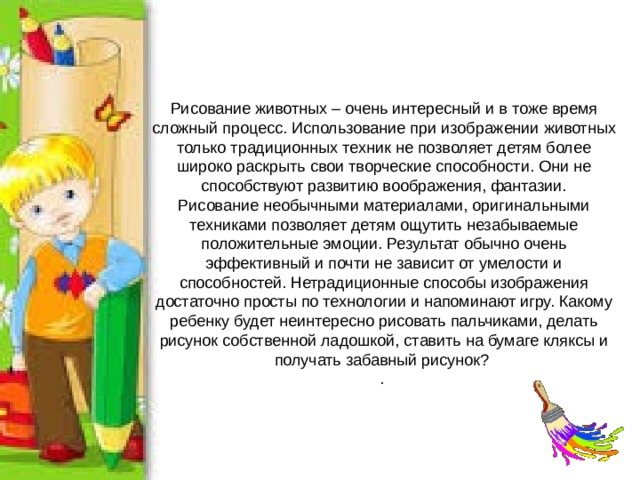
Drawing animals is a very interesting and at the same time complex process. Using only traditional techniques when depicting animals does not allow children to develop their creative abilities more widely. They do not contribute to the development of imagination and fantasy. Drawing with unusual materials and original techniques allows children to experience unforgettable positive emotions. The result is usually very effective and almost does not depend on skill and ability. Non-traditional methods of depiction are quite simple in technology and resemble a game. What child wouldn’t be interested in finger painting, making a drawing with his own palm, putting blots on paper and getting a funny picture? .
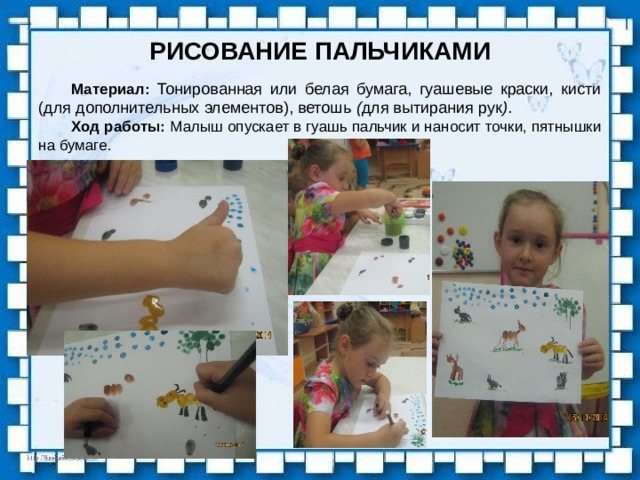
FINGER PAINTING
Material:
Tinted or white paper, gouache paints, brushes (for additional elements), rags
(
for wiping hands
)
.
Progress:
The kid dips his finger into the gouache and puts dots and spots on the paper.
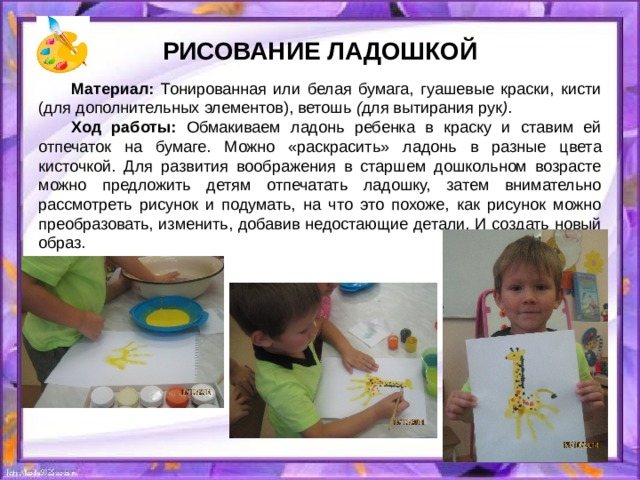
PALM DRAWING
Material:
Tinted or white paper, gouache paints, brushes (for additional elements), rags
(
for wiping hands
)
.
Progress:
We dip the child's palm in paint and make an imprint on the paper. You can “paint” your palm in different colors with a brush. To develop imagination in older preschool age, you can invite children to print a palm, then carefully examine the drawing and think about what it looks like, how the drawing can be transformed, changed by adding the missing details. And create a new image.
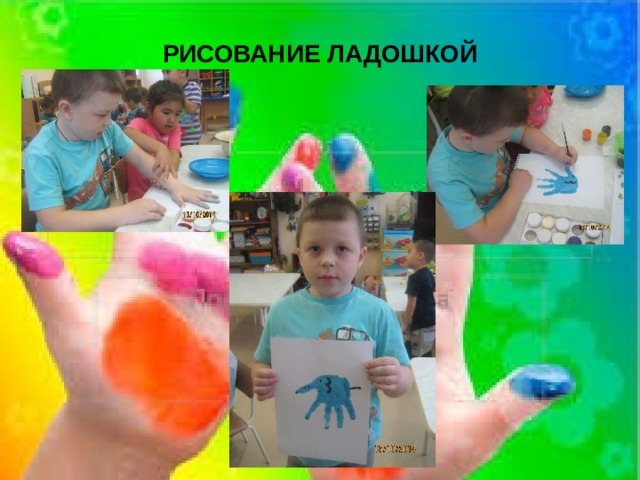
PALM DRAWING
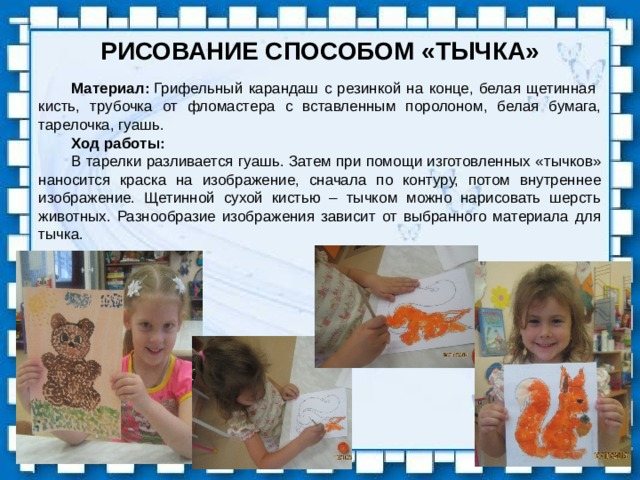
DRAWING WITH THE “POKE” METHOD
Material:
A lead pencil with an eraser at the end, a white bristle brush, a felt-tip pen tube with inserted foam, white paper, a plate, gouache.
Progress:
Gouache is poured into plates. Then, using the manufactured “poke”, paint is applied to the image, first along the contour, then the internal image. Using a bristle dry brush, you can use a poke to paint animal fur. The variety of images depends on the chosen material for the poke.
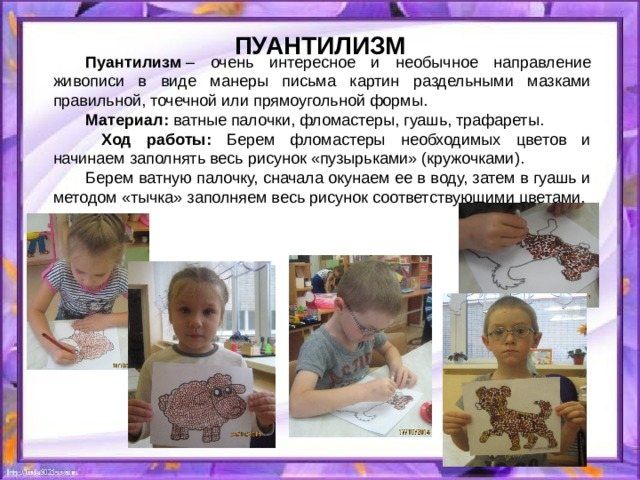
POINTILLISM
Pointillism
- a very interesting and unusual direction of painting in the form of a manner of painting pictures with separate strokes of a regular, dotted or rectangular shape.
Material:
cotton swabs, felt-tip pens, gouache, stencils.
Progress:
We take felt-tip pens of the required colors and begin to fill the entire drawing with “bubbles” (circles).
We take a cotton swab, first dip it in water, then in gouache and use the “poke” method to fill the entire drawing with the corresponding colors.

PAMPING
Material:
foam rubber, liquid gouache paints, plate.
Progress:
The ink pad serves as a palette. To change the color, you need to take a different foam. Using this technique, it’s good to draw something fluffy, light, airy, and transparent.
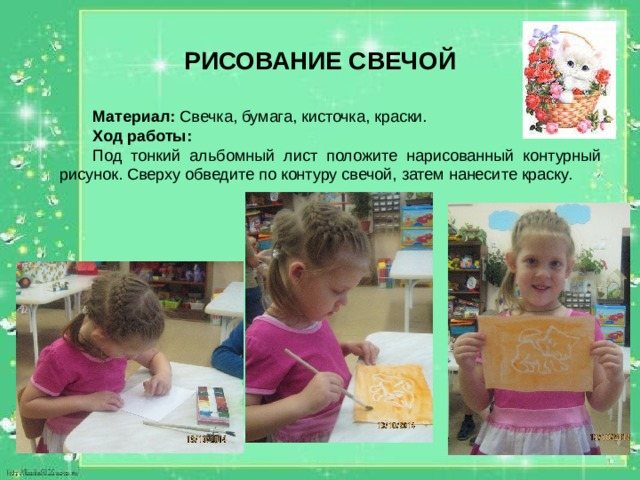
DRAWING WITH A CANDLE
Material:
Candle, paper, brush, paints.
Progress:
Place the drawn outline drawing under a thin landscape sheet. Trace the outline with a candle on top, then apply paint.

DRAWING WITH WAX CRAYONS
Material:
wax crayons, paints, paper
Progress:
First you need to draw a “wax” picture, and then paint over it with watercolor paint. The watercolor rolls off the thick brushstroke of the pastel and remains only on a blank sheet of paper. The emerging pattern is very bright, all the strokes and lines are visible.

SPRAY
Material:
old toothbrushes, gouache, paper, silhouettes.
Progress:
A little paint is collected on the tip of the brush. Tilt the brush over a sheet of paper and run the cardboard or comb over the pile. The splashes will scatter across the clean sheet. You can also cut out any silhouette and place it on a piece of paper and spray paint. Then remove the silhouette and you will be left with a trace; you can supplement it by painting on the missing lines with a brush.
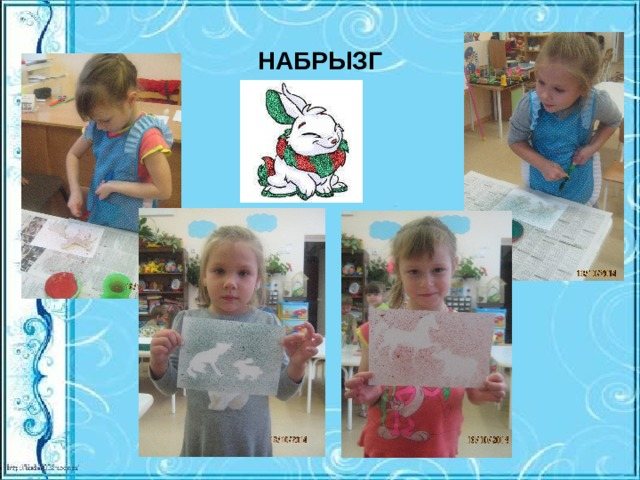
SPRAY
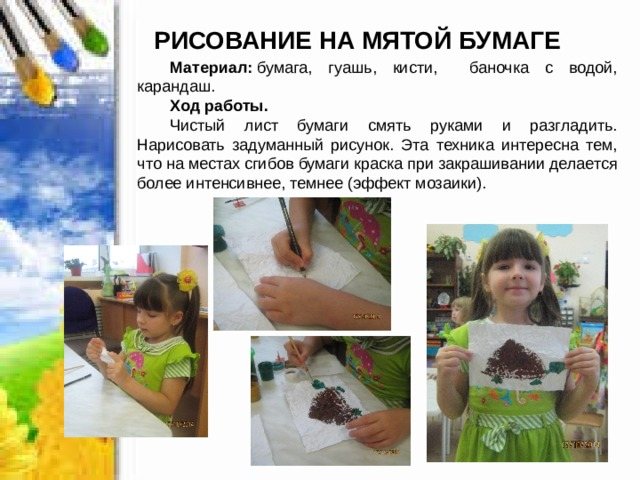
DRAWING ON CRUMPSED PAPER
Material:
paper, gouache, brushes, a jar of water, pencil.
Progress.
Crumple a clean sheet of paper with your hands and smooth it out. Draw the intended drawing. This technique is interesting because in the places where the paper is folded, the paint becomes more intense and darker when painted (mosaic effect).

DRAWING WITH CRUMPLED PAPER
Material:
paper, a piece of paper, gouache, a plate, a jar of water.
Progress:
crumple a piece of paper, dip it into a plate with gouache, then apply the drawing using the dip, complete the missing details of the drawing.
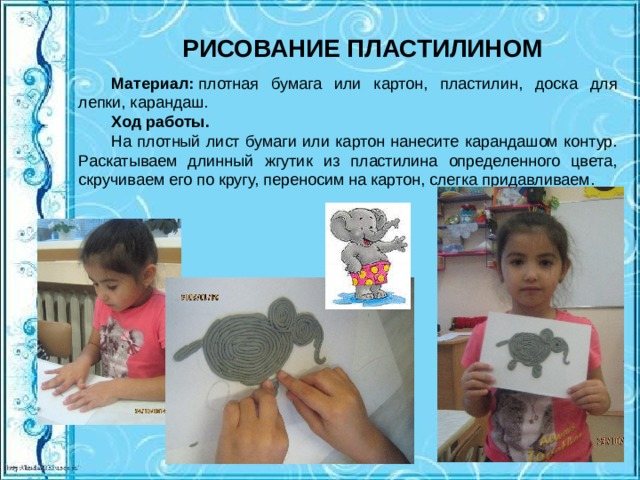
DRAWING WITH PLASTICINE
Material:
thick paper or cardboard, plasticine, modeling board, pencil.
Progress.
Draw an outline on a thick sheet of paper or cardboard with a pencil. We roll out a long rope of plasticine of a certain color, twist it in a circle, transfer it to cardboard, and press it lightly.
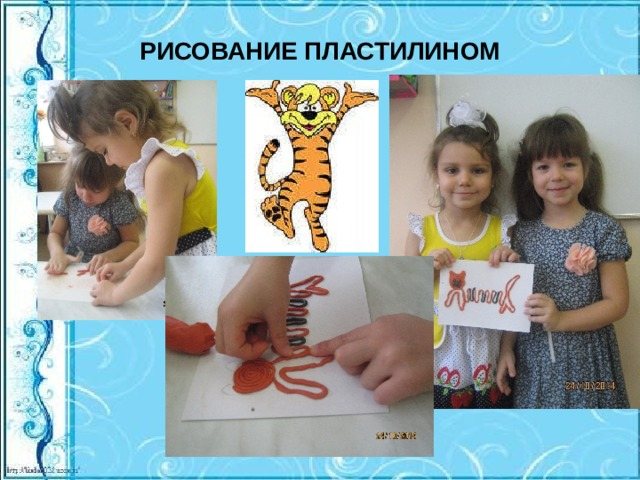
DRAWING WITH PLASTICINE

DRAWING ON SALT PAPER
Material:
paper with a pattern, salt, PVA glue, brushes, gouache paints, water, napkin.
Progress:
Stage 1: drawing the base with PVA glue and adding salt, leaving it to dry completely until the next lesson.
Stage 2: painting salted paper with gouache paints, choosing colors as you wish
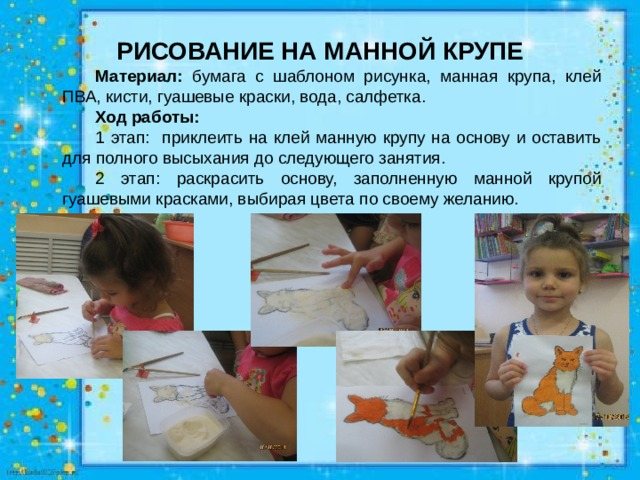
DRAWING ON SEMOLANA
Material:
paper with a pattern, semolina, PVA glue, brushes, gouache paints, water, napkin.
Progress:
Stage 1: glue semolina onto the base with glue and leave to dry completely until the next lesson.
Stage 2: paint the base filled with semolina with gouache paints, choosing colors as you wish.
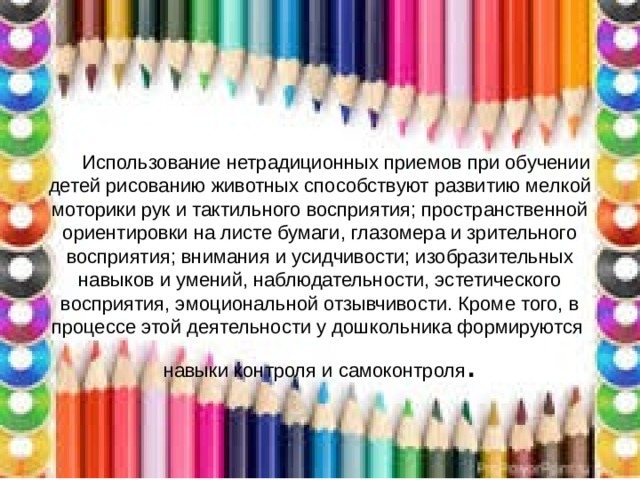
The use of unconventional techniques when teaching children to draw animals contributes to the development of fine motor skills and tactile perception; spatial orientation on a sheet of paper, eye and visual perception; attention and perseverance; visual skills and abilities, observation, aesthetic perception, emotional responsiveness. In addition, in the process of this activity, the preschooler develops control and self-control skills.
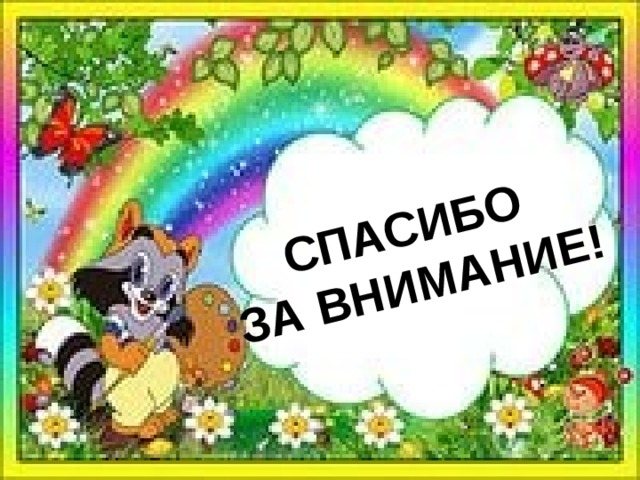
THANK YOU
FOR YOUR ATTENTION!
Summary of a lesson in the middle group on drawing animals in unconventional ways
Svetlana Danilova
Summary of a lesson in the middle group on drawing animals in unconventional ways
Municipal budgetary preschool educational institution general developmental kindergarten No. 37 “Fairy Tale”
Tuapse municipality Tuapse district
Summary of direct educational activities for children of the middle group in the educational field “Artistic Creativity”
(
drawing in non-traditional ways ) on the topic
“Guys visiting the bear cubs”
Performer: Danilova S. A.
Tasks. Teach children to draw animals using the poking method . Strengthen the ability to paint with a brush in different ways . Develop the ability to independently choose the color scheme for an image; Ability to properly use a brush and napkin. Cultivate a desire to help. Develop an imaginative interest in the visual arts.
Preliminary work. Looking at illustrations of animals . Reading the fairy tale “The Three Bears”
.
Material. a landscape sheet with drawn outline of a bear in different poses; 2 brushes (hard and thin, equipment for painting . Two samples: on one, an outline of a bear; on the other, a bear drawn using the poking method . Bear mask, toy bears.
Examples of completed works of middle group students with comments on the completion of the work
The children enjoy creating illustrations for their favorite fairy tales - plot compositions “The Angry Wolf” (a character from the fairy tale “Little Red Riding Hood” by Charles Perrault), “The Three Bears”, “The Three Little Pigs” (heroes of the works of the same name in Russian and English folklore).
The technique of poking with a dry brush is very appropriate for depicting animals. It allows you to convey the shaggyness of the skin or the fluffiness of the animal’s fur. The compositions “Bear Cub”, “Hare”, “Red Cat”, “Teddy Bear”, “Cat Eating from a Bowl” were performed in this unconventional way.
Some animals are very good to draw with the help of your palms, for example, this is the work “Giraffe”. And to draw the spines of a hedgehog, there is no better tool than a fork (the work of a spiny hedgehog").
The children really like to complement the images of animals with characteristic attributes. This is a mushroom and a cone for a squirrel (drawing “Squirrel with a fungus”), a bowl from which there is a cat (“The cat eats from a bowl”). And the little goats are grazing in the meadow, decorated with beautiful flowers (“The little goats are out on the meadow”, “The little goat is grazing in the meadow”).
Photo gallery: a selection of children's drawings
Illustration for the fairy tale “Little Red Riding Hood”
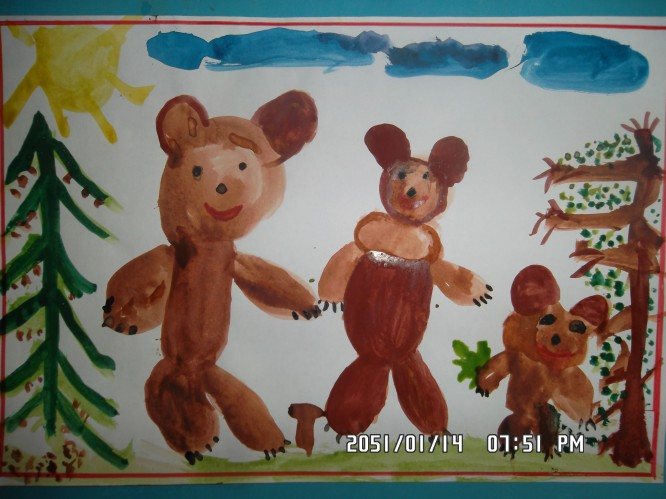
Illustration for a fairy tale

Drawing with gouache
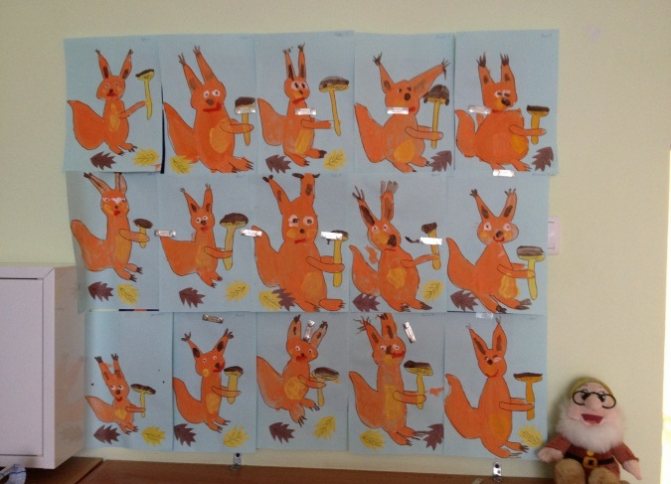
Drawing with watercolors
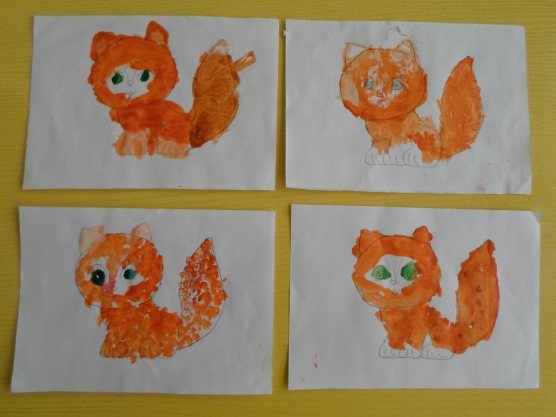
Drawing with watercolors

Poking drawing
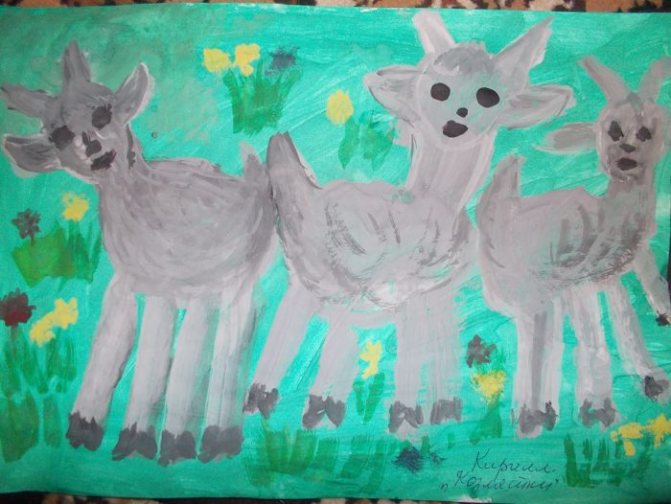
Drawing with gouache
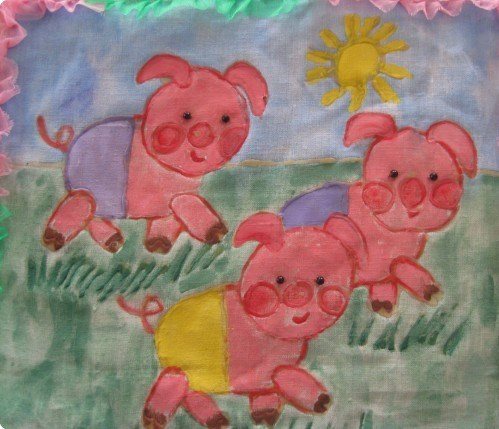
Drawing with watercolors
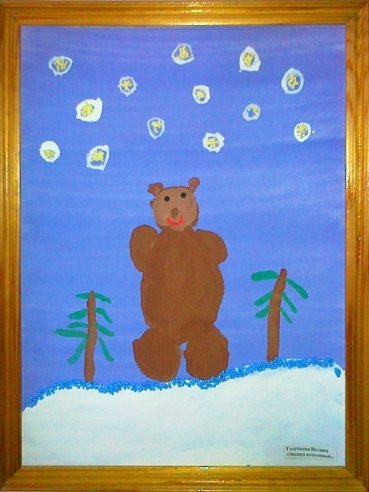
Drawing with gouache
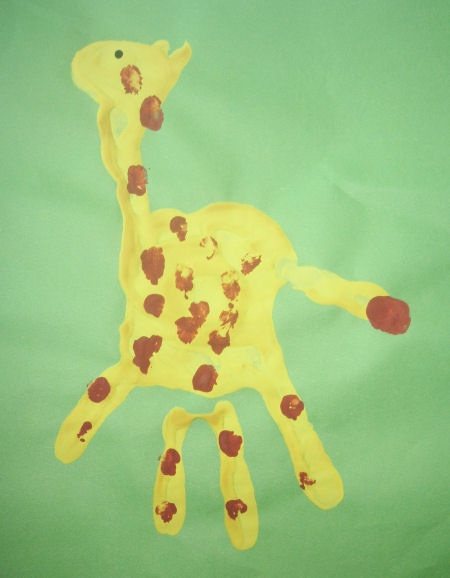
Palm drawing

Drawing with gouache
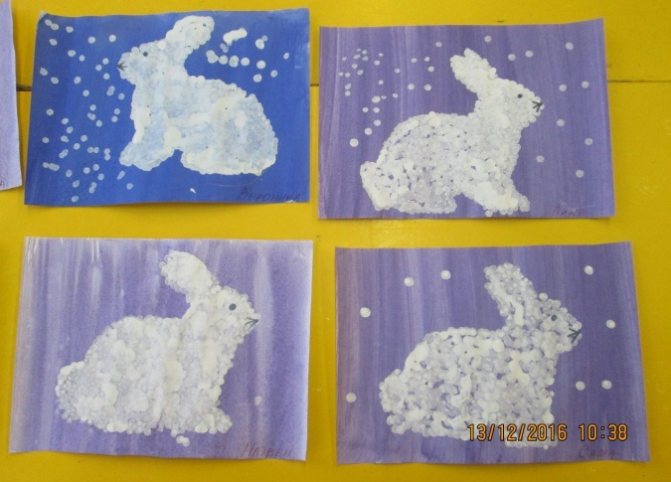
Poking drawing
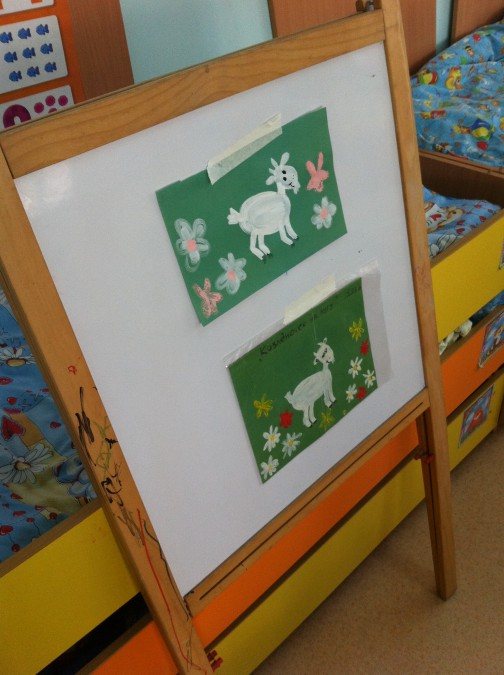
Drawing with gouache on colored paper
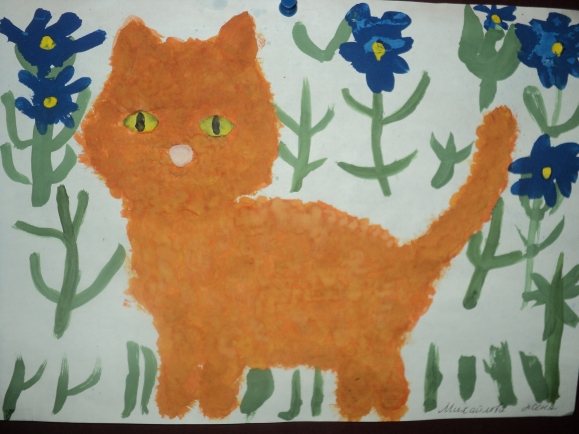
Poking drawing

Rich gouache
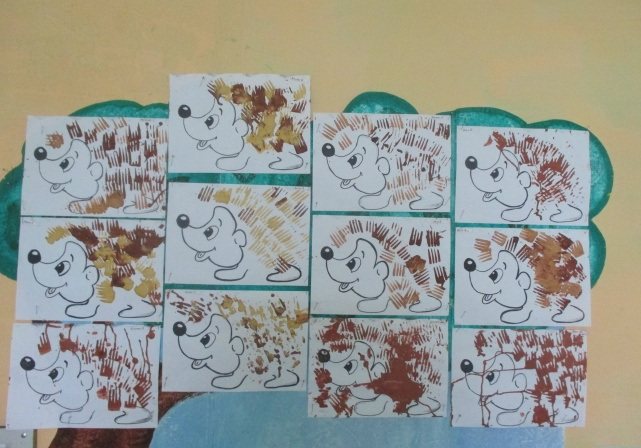
Drawing with a fork
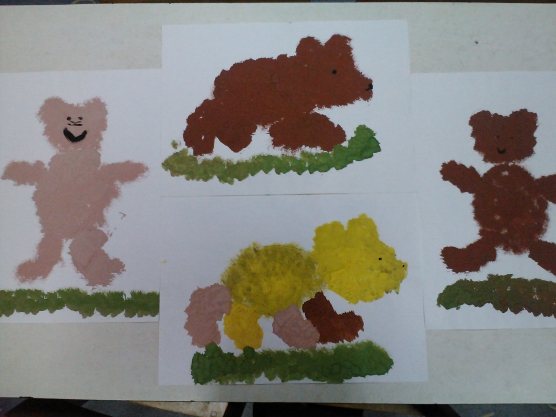
Poking drawing
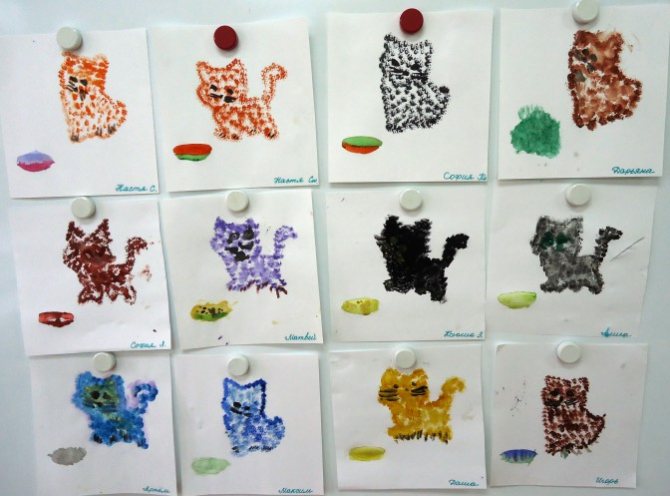
Poking drawing
A good help for preschoolers is step-by-step drawing. The guys learn not to make mistakes and develop a certain algorithm for depicting an animal. After several trainings, they are quite able to draw an object without a diagram. In addition, it is a very exciting process to watch how the shapes and strokes create an image of an animal.
On the topic: methodological developments, presentations and notes
Nurturing the sound culture of speech, vocabulary, the formation of the grammatical structure of speech, its coherence when constructing a detailed statement.
GCD for the artistic and aesthetic development of children 4-5 years old (design).
This entertainment is carried out with a group of children of primary preschool age. By holding this event, we fix the names of wild animals (hare, bear, squirrel). We create positive attitudes in children.
Summary of continuous educational activities on cognitive and speech development in the middle group with a general developmental focus on the topic: “Ka.
To create conditions for enriching the motor experience of young children through the use of the Russian folk tale “Zayushkina’s Hut.”
Goal: to develop children's interest in mathematical games, the main purpose of which is to ensure that children exercise in distinguishing, highlighting, and naming sets of objects, numbers, and geometric ones.
Notes on cognitive development “Acquaintance with the world around us” in the second junior group “Visiting forest animals” Types of activity: cognitive and research.
Source
.Teach children to draw animals using an unconventional technique - poking with a hard brush.
On the topic: methodological developments, presentations and notes
Goal: forming the foundations of patriotic education, spiritual and moral culture of children, nurturing a sense of patriotism, love for one’s hometown. Objectives: Educational:-.
Summary of educational activities in the middle group on speech development using ICT (photo-case technology).
Lesson notes on ecology for the middle group.
Summary of educational activities in the middle group of kindergarten on the topic “Cat”.
Summary of educational activities to familiarize yourself with the environment on the topic “Wild animals. Seasonal changes in the life of animals" for children of the middle group.


